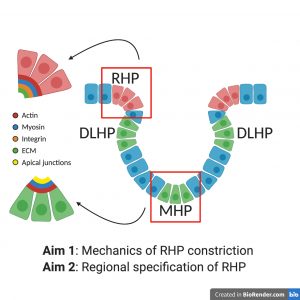Brain Development Project
Currently recruiting PhD, Masters students and Undergraduate Researchers to work on this project.
ABSTRACT
Neural tube defects (NTDs) are the second most common structural birth defect, yet despite their high frequency, the fundamental mechanisms that shape the neural tube are still poorly understood. During neurulation, the neural plate bends and folds in a biphasic manner around a medial and bi-lateral hingepoints, bringing the neural folds in close apposition and leading to their fusion, which completes neural tube formation. The discovery of the medial hingepoint was pivotal to the field, as it not only provided a mechanistic explanation for how the flat neural plate initially bends into a V shape, but it also led to the identification of several causative mutations in patients with NTDs. In contrast to the central region of the neural plate, the edges of this epithelial layer fold in the opposite direction to shape the neural folds. It stands to reason that this process would involve a reverse change in cell shape (reverse hingepoint or RHP) and preliminary data confirms this prediction, however a molecular understand of this process is lacking. We propose to test the central hypothesis that RHP formation is driven by recruitment of contractile machinery to the basal pole of neural fold cells, downstream of spatial information conveyed by forebrain-specific transcription factors. In aim 1 we will investigate the molecular mechanisms that shape RHP cells and in aim 2 we will examine how regional identity conveyed by forebrain-specific transcription factors species where RHPs form.

Upon completion of the proposed studies, we will understand key cellular and molecular mechanisms that mediate RHP formation and have filled an important gap in our basic knowledge of neurulation. These studies will pave the way towards identification of novel NTD genetic risk factors by providing a developmental framework for functional validation of human variants in candidate genes such as emx2 and integrin b1.